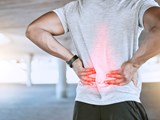Whether your standing, walking, running or jumping, Tyfo insoles instantly generate higher levels of force when you contact the ground - these increased forces decide how much energy your Feet and body get to use for all your daily activities.
Did You Know?
Lower back pain is one of the most common health complaints worldwide.
Lower back pain isn't just a physical ailment! It's a daily barrier that affects every facet of life. From the simple joy of bending to tie a shoe, to the restless nights longing for a pain-free sleep, lower back pain can transform routine tasks into challenging hurdles.
It hinders our ability to work efficiently, engage in recreational activities, and even share precious moments with loved ones. The constant discomfort serves as a reminder of the activities we once took for granted, now overshadowed by the persistent ache.
Take the first step towards a pain-free back
with 60 Day Money Back Guarantee!
Understanding What Causes Lower Back Pain: The Foundation for Relief
Understanding that lower back pain can arise from a myriad of sources, including acute injuries, chronic conditions, and lifestyle factors, it's crucial to approach relief and management with a comprehensive strategy. The discomfort stemming from muscle or ligament strains, disc issues, arthritis, osteoporosis, skeletal irregularities, poor posture, or a sedentary lifestyle necessitates a multifaceted approach to treatment and prevention.
Lower Back Stretches
Help relieve pain by loosening tight muscles, increasing flexibility, and improving blood circulation to the affected area. Stretches gently extend the spinal muscles, reducing stiffness and promoting mobility. Regularly performing these exercises can also strengthen back muscles, supporting the spine more effectively and reducing the likelihood of future discomfort.
Physical Therapy
Physical therapists can tailor specific exercises to strengthen the muscles supporting your back and improve your posture, which can help relieve pain. Core strengthening exercises, flexibility routines, and aerobic activities are often recommended.
Weight Management
Excess body weight puts additional stress on your back. Maintaining a healthy weight through diet and exercise can help relieve back pain and prevent future episodes.
Pain Medications
Over-the-counter (OTC) pain relievers like ibuprofen (Advil, Motrin IB) or acetaminophen (Tylenol) can be effective for short-term relief. In more severe cases, your doctor may prescribe stronger medications.
Proper Lifting Techniques
Learning and consistently applying proper lifting techniques can prevent back pain from arising due to strain or injury. Always lift from your knees, not your back, and avoid twisting your torso while lifting.
Heat and Cold Therapy
Applying heat packs or cold packs to the affected area can offer immediate pain relief. Heat therapy increases blood flow and soothes discomfort, while cold therapy reduces inflammation and numbs deeper layers of muscle.
Ergonomic Adjustments
Making changes to your work and home environments to support your back better can prevent pain. This includes using chairs with proper lumbar support, standing desks, and ergonomic pillows and mattresses.
Foot Support
Proper foot support, through the use of orthotic insoles, can play a crucial role in aligning the spine and reducing lower back pain. Insoles can correct posture imbalances and distribute weight more evenly, alleviating stress on the lower back.
One often overlooked but crucial element in relieving or preventing Lower Back Pain is the importance of having Strong Activated Feet - and it’s never too late to start.
Explore our New Products now!
THE HIDDEN MOTOR MECHANISM
Researchers have recently announced the discovery of a hidden Foot Motor that can create higher energy levels when activated correctly - Tyfo insoles are the first brand to activate this hidden Motor.
Reclaim the life you deserve.
Click now to explore our collection now available starting from just £65!


